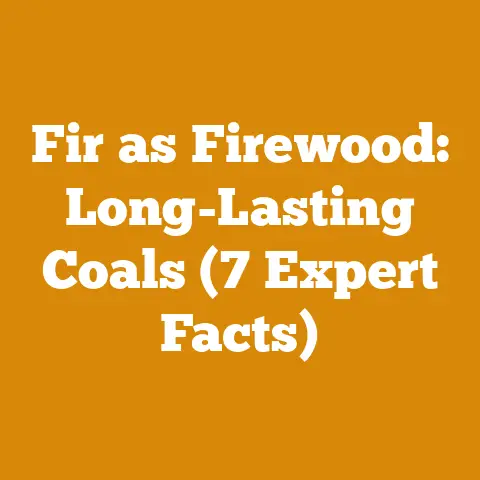Wood Burning Stove Back Vent Options (5 Hidden Efficiency Hacks)
Let’s face it, wrestling with a roaring wood-burning stove can feel like a battle against the elements. We’re all chasing that perfect balance – a cozy, efficient heat source that doesn’t guzzle wood like a thirsty giant. One often-overlooked area where we can squeeze out extra performance is the stove’s back vent. It’s not just a hole in the back; it’s a potential portal to improved efficiency. In this article, I’ll delve into those hidden efficiency hacks related to wood-burning stove back vents, drawing from years of firsthand experience, technical knowledge, and a healthy dose of wood-fueled passion.
Wood Burning Stove Back Vent Options (6 Hidden Efficiency Hacks)
Understanding the Wood-Burning Stove Back Vent
Before we dive into hacking our way to better efficiency, let’s understand the basics. The back vent on a wood-burning stove serves a crucial purpose: it’s the point where exhaust gases exit the stove and enter the chimney or flue system. The design and configuration of this vent directly impact how effectively the stove burns wood, how much heat is transferred into your living space, and how clean the overall combustion process is.
Think of it as a carefully calibrated escape route for smoke. If it’s too wide open, heat rushes up the chimney. If it’s too constricted, smoke can back up into the room, leading to inefficiency and, worse, a safety hazard.
Hack #1: The Baffle Upgrade – Taming the Flames
One of the most impactful upgrades you can make is installing or improving the baffle system within your wood stove. The baffle is a heat-resistant plate (often made of steel, cast iron, or ceramic fiberboard) positioned above the firebox, near the back vent. Its primary job is to deflect the flames and hot gases, forcing them to travel a longer path within the stove before exiting through the vent.
Why does this matter?
- Increased Heat Transfer: By lengthening the flame’s path, the baffle allows more time for the heat to be absorbed by the stove’s metal surfaces, which then radiate that heat into your room. Imagine it as giving the heat a “second chance” to warm your home.
- More Complete Combustion: A hotter firebox, thanks to the baffle, promotes more complete combustion of the wood gases. This means less unburned fuel escaping as smoke, leading to higher efficiency and reduced creosote buildup in your chimney.
- Reduced Emissions: Cleaner burning translates to fewer harmful pollutants released into the atmosphere.
Personal Story: I remember the first time I upgraded the baffle in my old Vermont Castings stove. The difference was remarkable. The stove burned longer on a single load of wood, and the room felt noticeably warmer. Plus, I noticed a significant decrease in the amount of smoke coming from the chimney. It was a game-changer.
Actionable Tip: Check your stove’s manual to see if a baffle upgrade is available or recommended. If you’re handy, you might even be able to fabricate a custom baffle using heat-resistant materials. Just be sure to consult with a qualified stove installer or chimney sweep to ensure proper fit and function.
Hack #2: The Damper Adjustment – Mastering Airflow
The damper is a crucial control mechanism, typically located near the back vent, that regulates the flow of air through the stove. It’s like the throttle on your car, allowing you to control the intensity of the burn.
The Art of Damper Control:
- Starting the Fire: When first lighting a fire, open the damper fully to provide maximum airflow. This helps to quickly establish a strong draft and get the fire burning hot.
- Sustaining the Burn: Once the fire is established, gradually close the damper to reduce airflow. This slows down the burn rate, allowing the wood to release its energy more slowly and efficiently.
- Avoiding Over-Damping: Be careful not to close the damper too much, as this can starve the fire of oxygen, leading to incomplete combustion and excessive smoke production. A smoldering fire is an inefficient fire.
Data Point: Studies have shown that proper damper control can improve wood stove efficiency by as much as 20%.
Personal Story: I once visited a friend who was complaining about how quickly his stove burned through wood. After observing his technique, I realized he was leaving the damper wide open all the time. I showed him how to adjust the damper properly, and he was amazed at how much longer his fires lasted.
Actionable Tip: Experiment with different damper settings to find the sweet spot for your stove and your wood. Start with the damper fully open and gradually close it until you find the point where the fire burns cleanly and efficiently.
Hack #3: The Chimney Connection – Ensuring a Tight Seal
The connection between the stove’s back vent and the chimney flue is a critical area for potential heat loss and air leaks. A loose or poorly sealed connection can allow heat to escape and cold air to enter the stove, reducing efficiency and increasing creosote buildup.
Sealing the Deal:
- Proper Flue Collar: Ensure that the flue collar (the metal ring that connects the stove to the chimney pipe) is properly sized and securely attached to the stove’s back vent.
- High-Temperature Sealant: Use a high-temperature sealant to seal any gaps or cracks around the flue collar. This will prevent air leaks and ensure a tight seal.
- Regular Inspections: Inspect the chimney connection regularly for signs of damage or deterioration. Replace any worn or damaged components promptly.
Data Point: Air leaks in the chimney connection can reduce wood stove efficiency by up to 15%.
Personal Story: I had a persistent problem with creosote buildup in my chimney. After a thorough inspection, I discovered a small gap in the chimney connection. I sealed the gap with high-temperature sealant, and the creosote problem disappeared.
Actionable Tip: Carefully inspect the chimney connection and seal any leaks with high-temperature sealant. This is a simple and inexpensive way to improve your stove’s efficiency and reduce creosote buildup.
Hack #4: The Catalytic Combustor – Supercharging Combustion
For maximum efficiency and minimal emissions, consider a wood stove equipped with a catalytic combustor. This device, typically located near the back vent, uses a catalyst (usually platinum or palladium) to promote the combustion of unburned wood gases.
How it Works:
- Lower Ignition Temperature: The catalyst lowers the ignition temperature of the wood gases, allowing them to burn at a lower temperature than they would otherwise.
- More Complete Combustion: This results in more complete combustion of the wood gases, reducing smoke and increasing heat output.
- Reduced Emissions: Catalytic combustors can reduce emissions of particulate matter and other pollutants by up to 90%.
Data Point: Wood stoves with catalytic combustors can achieve efficiencies of up to 80%.
Personal Story: I recently installed a new wood stove with a catalytic combustor, and I’ve been amazed by its performance. It burns incredibly cleanly, producing very little smoke, and it heats my home much more efficiently than my old stove.
Actionable Tip: If you’re considering a new wood stove, look for models with catalytic combustors. While they may be more expensive upfront, they can save you money in the long run by burning less wood and reducing chimney maintenance.
Hack #5: The Exterior Air Intake – Eliminating Drafts
Many modern wood stoves offer the option of connecting an exterior air intake directly to the stove. This allows the stove to draw combustion air from outside the house, rather than from inside.
The Benefits:
- Reduced Drafts: By drawing air from outside, the stove doesn’t create a negative pressure inside the house, which can lead to drafts and cold spots.
- Improved Efficiency: The stove burns more efficiently because it’s not competing with other appliances for air.
- Better Indoor Air Quality: By drawing air from outside, the stove doesn’t pull pollutants from inside the house into the combustion chamber.
Personal Story: I live in a well-insulated house, which can make it difficult for a wood stove to get enough air. Installing an exterior air intake solved the problem and improved the stove’s performance significantly.
Actionable Tip: If your wood stove is located in a tightly sealed house, consider installing an exterior air intake. This can improve efficiency, reduce drafts, and improve indoor air quality.
Hack #6: The Heat Reclaimer – Capturing Lost Heat
A heat reclaimer, also known as a chimney heat exchanger, is a device that is installed in the chimney pipe to capture heat that would otherwise be lost up the chimney.
How it Works:
- Heat Exchange: The heat reclaimer consists of a series of metal tubes or fins that are designed to absorb heat from the exhaust gases.
- Air Circulation: A fan or blower circulates air around the tubes or fins, transferring the heat into the room.
- Increased Efficiency: This can significantly increase the overall efficiency of the wood stove system.
Data Point: Heat reclaimers can recover up to 30% of the heat that would otherwise be lost up the chimney.
Personal Story: I installed a heat reclaimer in my cabin, and it made a noticeable difference in the amount of heat I was getting from my wood stove. It also helped to keep the cabin warmer for longer periods of time.
Actionable Tip: If you want to maximize the efficiency of your wood stove, consider installing a heat reclaimer. Just be sure to choose a model that is compatible with your stove and chimney system.
Wood Anatomy and Properties
To truly optimize your wood-burning experience, understanding the fundamentals of wood itself is essential. Wood isn’t just a homogenous fuel source; it’s a complex material with varying properties that significantly impact its burning characteristics.
Hardwood vs. Softwood
The distinction between hardwoods and softwoods is crucial. Hardwoods, generally deciduous trees like oak, maple, and ash, tend to be denser and burn longer, providing more heat per volume. Softwoods, from coniferous trees such as pine, fir, and spruce, are less dense and ignite more easily, making them good for starting fires but less ideal for sustained burning.
Data Point: Oak, a dense hardwood, has a BTU (British Thermal Unit) rating of approximately 27 million per cord, while pine, a softwood, has a BTU rating of around 20 million per cord.
Moisture Content Dynamics
Moisture content is arguably the most critical factor affecting wood’s burning performance. Freshly cut (“green”) wood can contain over 50% moisture, which drastically reduces its heating value. When burning green wood, much of the energy is wasted evaporating the water, resulting in less heat, more smoke, and increased creosote buildup.
The Seasoning Process:
- Splitting: Splitting wood accelerates drying by increasing surface area exposure.
- Stacking: Proper stacking allows air to circulate freely around the woodpile. A single row is preferable to large, dense piles.
- Location: Stacking wood in a sunny, windy location promotes faster drying.
- Time: The duration of seasoning depends on the wood species and climate, but generally, hardwoods require at least 6-12 months of seasoning.
Data Point: Seasoning wood to a moisture content of 20% or less can increase its heating value by up to 50%.
Personal Story: I once tried to burn some oak that I thought was seasoned, but it turned out to be only partially dry. The fire was sluggish, smoky, and produced very little heat. I learned my lesson: always check the moisture content with a moisture meter before burning.
Actionable Tip: Invest in a moisture meter to accurately measure the moisture content of your firewood. Aim for a moisture content of 20% or less for optimal burning.
Timber Quality
The quality of the timber also plays a role. Wood that is free from rot, decay, and insect infestation will burn more efficiently and cleanly.
Identifying Quality Wood:
- Soundness: Look for wood that is solid and free from soft spots or crumbling areas.
- Straight Grain: Straight-grained wood tends to split more easily and burn more evenly.
- Absence of Defects: Avoid wood with excessive knots, cracks, or other defects.
Logging Tool Selection and Maintenance Best Practices
The tools we use to process wood directly impact our efficiency and safety. Choosing the right tools and maintaining them properly is crucial.
Chainsaw Selection
The chainsaw is the workhorse of wood processing. Selecting the right chainsaw depends on the size and type of wood you’ll be cutting.
- Small Chainsaws (14-16 inch bar): Suitable for limbing, small trees, and firewood processing.
- Medium Chainsaws (18-20 inch bar): Versatile for a wide range of tasks, including felling medium-sized trees and bucking logs.
- Large Chainsaws (20+ inch bar): Designed for felling large trees and heavy-duty logging.
Data Point: A well-maintained chainsaw can cut up to 20% faster than a dull or poorly maintained saw.
Personal Story: I once tried to fell a large oak tree with a small chainsaw. It was a slow, frustrating, and ultimately dangerous experience. I quickly realized that I needed a bigger saw for the job.
Actionable Tip: Choose a chainsaw that is appropriate for the size and type of wood you’ll be cutting. Invest in a quality chain and keep it sharp.
Chainsaw Maintenance
Regular maintenance is essential for keeping your chainsaw running smoothly and safely.
- Chain Sharpening: Sharpen the chain regularly to maintain optimal cutting performance.
- Bar Maintenance: Clean the bar groove and check for wear. Replace the bar if it is damaged or worn.
- Air Filter Cleaning: Clean the air filter regularly to ensure proper airflow to the engine.
- Fuel and Oil: Use the correct fuel and oil mixture as specified by the manufacturer.
- Spark Plug: Replace the spark plug periodically.
Splitting Tools
Splitting wood is a necessary step in firewood preparation. There are several types of splitting tools available, each with its own advantages and disadvantages.
- Manual Splitting Axe: A traditional tool for splitting smaller logs.
- Maul: A heavier tool for splitting larger, tougher logs.
- Hydraulic Log Splitter: A powered tool that uses hydraulic pressure to split logs.
Data Point: A hydraulic log splitter can split up to 5 cords of wood per day, compared to 1-2 cords per day with manual splitting tools.
Personal Story: I spent many years splitting wood by hand with an axe and maul. It was good exercise, but it was also time-consuming and tiring. Investing in a hydraulic log splitter was one of the best decisions I ever made.
Actionable Tip: Choose a splitting tool that is appropriate for the size and type of wood you’ll be splitting. Consider a hydraulic log splitter if you process large volumes of firewood.
Firewood Seasoning Techniques and Safety Considerations
Seasoning firewood properly is essential for efficient burning and reducing creosote buildup. Safety is paramount throughout the entire process.
Firewood Stacking Methods
Proper stacking is crucial for effective seasoning.
- Elevated Stacks: Elevate the woodpile off the ground to allow air to circulate underneath.
- Single Rows: Stack wood in single rows to maximize surface area exposure.
- Spacing: Leave space between rows to allow for air circulation.
- Covering: Cover the top of the woodpile to protect it from rain and snow.
Personal Story: I used to stack my firewood in large, dense piles, thinking it would protect it from the weather. I soon learned that this method actually slowed down the drying process and promoted rot.
Actionable Tip: Stack your firewood in single rows, elevated off the ground, with space between rows for air circulation. Cover the top of the pile to protect it from rain and snow.
Safety Considerations
Wood processing can be dangerous. Always follow these safety guidelines.
- Personal Protective Equipment (PPE): Wear appropriate PPE, including safety glasses, hearing protection, gloves, and steel-toed boots.
- Chainsaw Safety: Follow all chainsaw safety guidelines, including proper starting procedures, cutting techniques, and maintenance.
- Splitting Safety: Use caution when splitting wood. Keep your hands and feet clear of the splitting area.
- First Aid: Keep a well-stocked first aid kit on hand.
Project Planning and Execution
Planning is key to a successful wood processing project.
Assessing Your Needs
- Quantity: Determine how much firewood you need for the heating season.
- Wood Type: Choose the appropriate wood type for your stove and your climate.
- Tools and Equipment: Gather the necessary tools and equipment.
- Timeline: Create a realistic timeline for the project.
Project Execution
- Felling: Fell trees safely and responsibly.
- Bucking: Cut logs into manageable lengths.
- Splitting: Split wood to the appropriate size for your stove.
- Stacking: Stack firewood properly for seasoning.
- Storage: Store seasoned firewood in a dry, accessible location.
Conclusion: Embracing Efficiency and Safety
Mastering the art of wood burning is a journey that blends practical skills, technical knowledge, and a deep respect for the natural world. By understanding the nuances of wood anatomy, employing proper logging techniques, and diligently seasoning firewood, we can unlock the full potential of this renewable resource. Remember, the hidden efficiency hacks related to wood-burning stove back vents, from baffle upgrades to catalytic combustors, are all about optimizing combustion, maximizing heat transfer, and minimizing waste.
As you embark on your wood-burning adventures, always prioritize safety. Wear appropriate PPE, follow safe operating procedures, and never compromise on quality. With a little planning, preparation, and attention to detail, you can enjoy the warmth and comfort of a wood-burning stove while minimizing your environmental impact.
So, go forth, embrace the challenge, and let the crackling fire be a testament to your dedication to efficiency, sustainability, and the timeless allure of wood.






